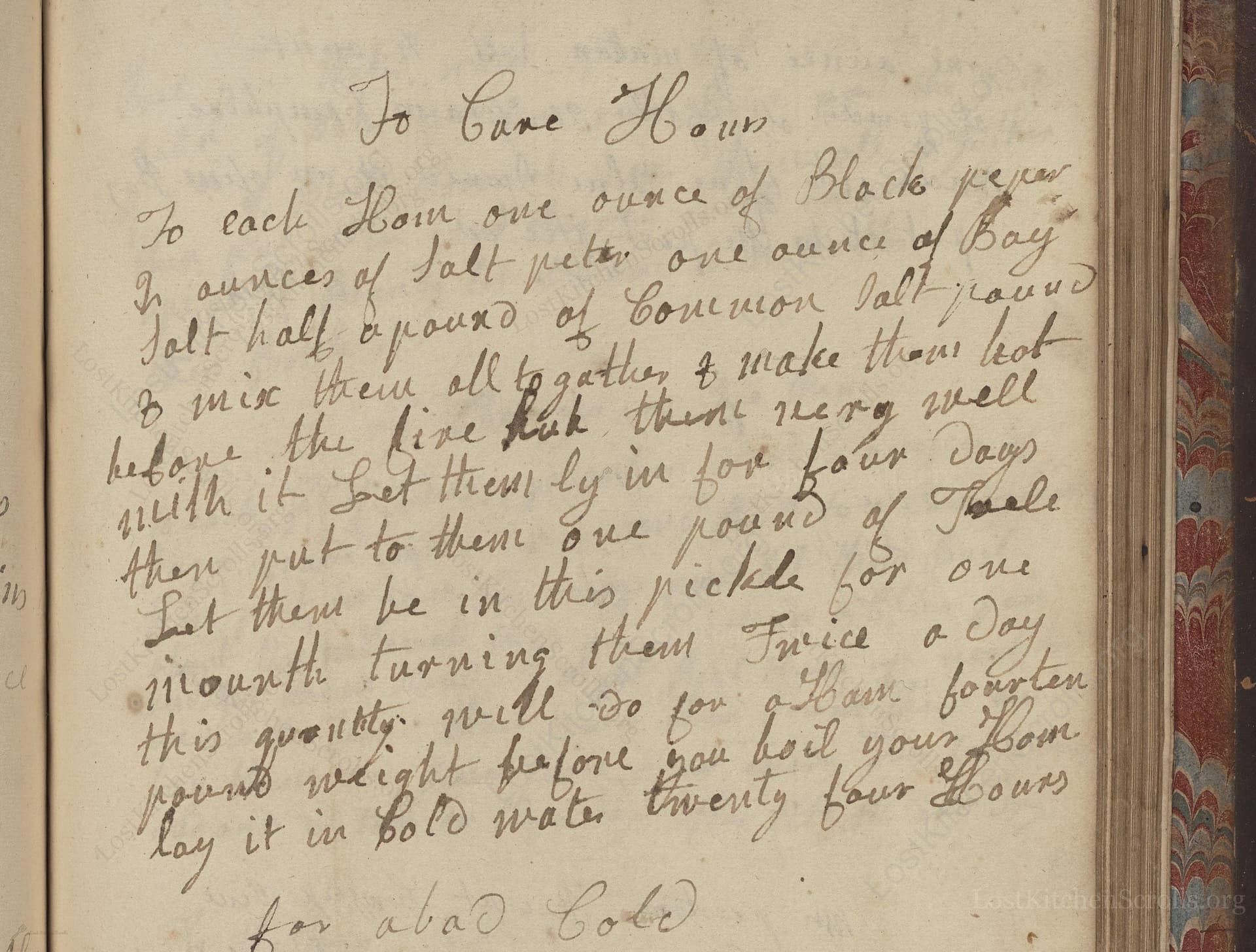To Cure Ham
From the treasured pages of Cookery and medicinal recipes of M.W.
Unknown Author

To Cure Ham
"To each Ham one ounce of Black peper 3 ounces of Salt peter one ounce of Bay Salt half a pound of Common Salt pound & mix them all together & make them hot before the fire Rub them very well with it Let them ly in for four days then put to them one pound of Treale Let them be in this pickle for one month turning them twice a day this quantity will do for a Ham fourten pound weight before you boil your Ham lay it in Cold water twenty four Hours"
Note on the Original Text
The recipe is written in a continuous, almost breathless paragraph, typical of early modern English cookery manuscripts. There is minimal punctuation and spelling is inconsistent: 'Treale' is treacle, and 'bay salt' is a coarse sea salt. Quantities are all by weight (ounces and pounds), reflecting the cook’s access to balances and scales even for household use. Past instructions assumed a basic familiarity with techniques—no explicit step-by-step, just a sequence of tasks. Cooks were expected to know how long to rub or what vessels to use, reflecting an oral tradition transitioning slowly into written forms.

Title
Cookery and medicinal recipes of M.W. (1775)
You can also click the book image above to peruse the original tome
Writer
Unknown
Era
1775
Publisher
Unknown
Background
A delightful glimpse into British kitchens of yesteryear, this manuscript collection—attributed simply to 'M. W.'—whisks readers through cherished recipes and culinary wisdom passed down between 1700 and 1850. A treasure trove for those who savor the artistry of historical cookery.
Kindly made available by
Folger Shakespeare Library
This recipe comes from a manuscript attributed to 'M. W.' and dates to somewhere between 1700 and 1850, a period when home-curing meat was essential for preservation before the era of refrigeration. Hams were often prepared in large batches at the end of autumn, to supply households through winter. Bay salt—a coarse, unrefined sea salt—reflected regional salt making practices of the time. The use of saltpeter was not only for flavor and preservation but also to keep the ham’s color pink and appetizing. Treacle, an affordable sugar byproduct, helped retain moisture and enhanced the ham's flavor. This recipe stands as a wonderful example of traditional English meat preservation, showing how home cooks utilized salt, spices, and patience to transform fresh pork into something both safe and delicious.

Cooks would use a large wooden trough or ceramic salting pan to hold the ham and cure mixture. Coarse linen or muslin cloths might cover the vessel. Manual labor was involved in rubbing the curing mixture into the meat and turning it daily. Open fireplaces supplied the gentle warmth to 'make hot' the salts and spices, though this would not have involved actual cooking—just a gentle warming by the fire’s side. No modern refrigeration—the coolest part of the larder or cellar would have to suffice!
Prep Time
30 mins
Cook Time
3 hrs
Servings
20
We've done our best to adapt this historical recipe for modern kitchens, but some details may still need refinement. We warmly welcome feedback from fellow cooks and culinary historians — your insights support the entire community!
Ingredients
- 1 ham (approx. 14 lbs / 6.3 kg)
- 1 oz ground black pepper
- 3 oz potassium nitrate (saltpeter)
- 1 oz bay salt (substitute: unrefined sea salt)
- 8 oz common salt (table or fine sea salt)
- 1 lb treacle (substitute: molasses or golden syrup)
Instructions
- To cure one ham (approximately 14 lbs), mix 1 oz black pepper, 3 oz potassium nitrate (saltpeter), 1 oz bay salt (use unrefined sea salt as substitute), and 8 oz regular salt.
- Blend these together and warm gently (without cooking) to enhance their aroma.
- Rub this mixture thoroughly into the ham and let it rest covered for four days in a cool place.
- After four days, add 1 lb treacle (also known as golden syrup or molasses), spreading it over the ham and ensuring it is well distributed.
- Place the ham in this seasoned 'pickle' for one month, turning it twice daily to ensure even curing.
- After curing, soak the ham in cold water for 24 hours before boiling to reduce saltiness.
Estimated Calories
300 per serving
Cooking Estimates
It will take just a few minutes to mix the spices, salts, and treacle, but you need to let the ham cure in the seasonings for about a month, turning it often. After curing, soak the ham for one day before boiling. The actual cooking after curing and soaking takes a few hours. One whole ham serves about 20 people, and each serving has around 300 calories, depending on how much fat is trimmed and how it's served.
As noted above, we have made our best effort to translate and adapt this historical recipe for modern kitchens, taking into account ingredients nowadays, cooking techniques, measurements, and so on. However, historical recipes often contain assumptions that require interpretation.
We'd love for anyone to help improve these adaptations. Community contributions are highly welcome. If you have suggestions, corrections, or cooking tips based on your experience with this recipe, please share them below.
Join the Discussion
Rate This Recipe
Dietary Preference
Main Ingredients

Den Bockfisch In Einer Fleisch Suppen Zu Kochen
This recipe hails from a German manuscript cookbook compiled in 1696, a time whe...

Die Grieß Nudlen Zumachen
This recipe comes from a rather mysterious manuscript cookbook, penned anonymous...

Ein Boudain
This recipe comes from an anonymous German-language manuscript cookbook from 169...

Ein Gesaltzen Citroni
This recipe, dating from 1696, comes from an extensive anonymous German cookbook...
Browse our complete collection of time-honored recipes



